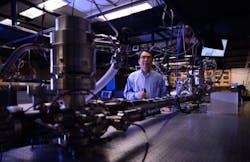Researchers from the Institute for the Frontier of Attosecond Science and Technology, CREOL, University of Central Florida (Orlando, FL) and the Beijing National Laboratory for Condensed Matter Physics, Institute of Physics, Chinese Academy of Sciences (Beijing, China) have demonstrated the shortest light pulse ever developed, a 53-attosecond x-ray (100 to 330 eV) flash produced via high-harmonic generation (HHG).1
The group, led by CREOL professor Zenghu Chang, beat its own world record set in 2012, in which 67-attosecond extreme ultraviolet (EUV) light pulses were created.
Producing attosecond x-rays requires a new type of high power driver: femtosecond lasers with a relatively long center wavelength of 1.8 μm producing two-optical-cycle driving pulses. It’s an approach that Chang and his team have pioneered.
The attosecond pulse duration is not transform-limited, but is instead limited by the frequency chirp of the pulses.
Attosecond light pulses allow scientists to capture "freeze-frame" images of fast-moving electrons in atoms and molecules with unprecedented sharpness. The pulses Chang and his team have now demonstrated are shorter in wavelength as well as duration. The wavelength band of the new pulses reaches an important spectral region, the so called "water window," where carbon atoms absorb strongly but water does not.
X-rays interact with tightly bound electrons in matter, providing another way to study ultrafast processes in materials with chemical element specificity. That capability is invaluable for the development of next-generation logic and memory chips for mobile phones and computers.
Source: https://today.ucf.edu/ucf-researchers-set-record-fastest-light-pulse/
REFERENCE:
1. Jie Li et al., Nature Communications (2017); doi: 10.1038/s41467-017-00321-0

